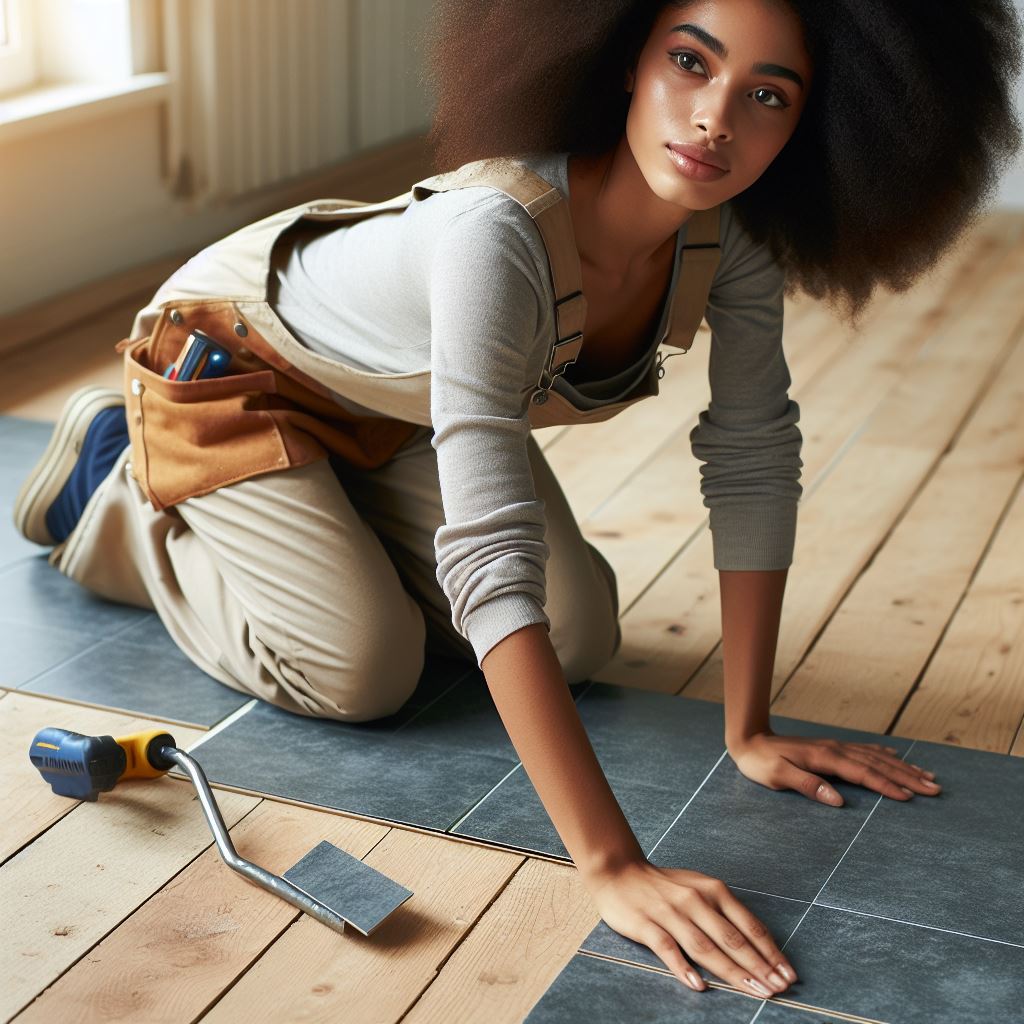Introduction
When it comes to real estate, flooring upgrades hold significant importance.
A well-maintained and attractive floor can increase the value of a property and attract potential buyers or tenants.
However, flooring upgrades can often be expensive, which is why many homeowners and investors look for economical options.
Fortunately, there are several strategies that can help achieve a cost-effective flooring upgrade without compromising on quality or aesthetics.
In this post, we will discuss various economical flooring upgrade strategies that can be applied to different types of properties.
These strategies include the use of alternative materials such as laminate or vinyl flooring, refinishing existing hardwood floors, and implementing budget-friendly tiling options.
By exploring these strategies, readers will gain insights on how to enhance the appearance and value of their properties while keeping costs in check.
Whether it is for a residential space or a commercial building, these economical flooring upgrade strategies offer practical solutions and creative ideas.
So, let’s dive into the world of flooring upgrades and discover the possibilities of transforming a space without breaking the bank.
Researching Cost-effective Flooring Materials
Thorough research before selecting flooring materials is crucial for an economical flooring upgrade.
It helps homeowners find the best options within their budget and ensures long-term satisfaction.
List of Economical Flooring Options
- Laminate flooring: Laminate flooring mimics the appearance of hardwood and is available at a significantly lower price. It is durable and easy to install, making it a popular choice.
- Vinyl flooring: Vinyl flooring comes in various styles, including tiles, planks, and sheets. It is highly durable, water-resistant, and budget-friendly.
- Cork flooring: Cork flooring is an eco-friendly option that offers both comfort and resilience. It provides sound insulation and is resistant to mold and mildew.
Benefits and Drawbacks of Each Material
Laminate Flooring
Benefits
- Lower cost compared to hardwood flooring.
- Durable and resistant to stains, scratches, and fading.
- Easy installation with click-and-lock or glue-down methods.
Drawbacks
- Cannot be refinished like hardwood flooring.
- May produce a hollow sound and feel underfoot.
- Quality may vary, so it is essential to choose a reputable brand.
Vinyl Flooring
Benefits
- Affordable and available in various designs, including realistic wood and stone looks.
- Water-resistant, making it suitable for areas prone to moisture, such as bathrooms and kitchens.
- Low-maintenance and easy to clean.
Drawbacks
- Not as durable as laminate or hardwood flooring.
- May show wear and tear over time, especially in high-traffic areas.
- May emit VOCs (volatile organic compounds) during installation.
Cork Flooring
Benefits
- Eco-friendly and sustainable choice made from renewable cork oak bark.
- Provides cushioning and insulation, reducing noise and energy consumption.
- Hypoallergenic and resistant to mold, mildew, and pests.
Drawbacks
- Requires regular sealing to maintain water resistance.
- May get dented or scratched easily, especially in high-traffic areas.
- Limited design options compared to laminate or vinyl flooring.
Tips and Considerations for Shopping
When shopping for cost-effective flooring materials, keep these tips in mind:
- Set a budget and stick to it, including both material and installation costs.
- Compare prices from different suppliers and consider purchasing during sales or promotions.
- Read reviews and gather information about the durability and performance of the materials.
- Consider the specific needs of each room, such as moisture resistance for bathrooms.
- Get samples and see how the materials look under different lighting conditions in your space.
- Check the warranty offered by the manufacturer to ensure product quality and longevity.
- Consider installation costs and complexity. Some materials are DIY-friendly, while others require professional assistance.
- Take into account the maintenance requirements of each material, as this can impact long-term costs.
By researching cost-effective flooring materials and considering these factors, homeowners can make informed decisions and achieve a beautiful and budget-friendly flooring upgrade.
Read: Renovation Costs: Plan Your Dream Home

Utilizing DIY Installation Techniques
When it comes to upgrading your flooring, DIY installation can be a cost-saving aspect that shouldn’t be overlooked.
Not only does it help save on labor costs, but it also gives you the freedom to choose your own materials and design.
Cost-saving aspect of DIY flooring installation
- Eliminates the need for professional installers, saving you money.
- You can take advantage of seasonal sales and discounts on flooring materials.
- No need to pay for transportation costs or additional fees for hiring professionals.
Importance of proper preparation and tools
- Ensure a smooth installation process by properly preparing the area.
- Thoroughly clean and level the subfloor to avoid future problems.
- Invest in the necessary tools such as a utility knife, measuring tape, and a rubber mallet.
- Having the right tools will make the installation process easier and more efficient.
Step-by-step instructions for DIY installation
- Start by measuring the area and calculating the amount of flooring material needed.
- Acquire the chosen flooring material and let it acclimate to the room’s temperature for 48 hours.
- Remove the existing flooring and ensure the subfloor is clean, dry, and level.
- Begin installation in the corner of the room, using spacers to maintain proper expansion gaps.
- Follow the manufacturer’s instructions for your specific flooring material.
- Secure the planks or tiles using adhesive, nails, or interlocking mechanisms.
- Cut the pieces to fit along the edges or around obstacles, using a utility knife or a saw.
- Continue laying the flooring until the entire area is covered.
- Remove the spacers and install baseboards or trim to complete the look.
Tips, tricks, and precautions for a successful installation
- Always wear safety goggles and gloves when working with tools or chemicals.
- Choose a flooring material that suits the function and traffic of the room.
- Acquire extra materials in case of mistakes or future repairs.
- Regularly clean and maintain the flooring to prolong its lifespan.
- If unsure, seek advice from professionals or follow online tutorials for guidance.
- Take breaks during the installation process to avoid fatigue and maintain accuracy.
By utilizing DIY installation techniques, you can save money on flooring upgrades without compromising on quality.
With proper preparation, tools, and step-by-step instructions, you can successfully install your chosen flooring material.
Just remember to follow tips, tricks, and precautions to ensure a long-lasting and visually appealing result. Happy flooring upgrading!
Read: Smart Budget Tips for Kitchen Makeovers
Refinishing and Reviving Existing Flooring
Refinishing existing flooring can be a budget-friendly alternative, saving you money while upgrading your home.
Types of Flooring that Can be Refinished
- Hardwood floors are a popular choice for refinishing as they can be sanded and sealed.
- Certain types of tile, such as ceramic or terrazzo, can also be refinished with the right techniques.
The Process of Refinishing Different Types of Flooring
Refinishing hardwood floors
- Start by preparing the area, removing all furniture, rugs, and debris from the floor.
- Thoroughly clean the floor using a vacuum cleaner or broom to remove any dirt or dust.
- Sand the floor using a drum sander or orbital sander, working in the direction of the wood grain.
- After sanding, vacuum the floor again to remove any remaining dust.
- Apply wood stain or sealant to enhance the color and protect the wood.
- Allow the stain or sealant to dry completely before applying a topcoat or polyurethane finish.
- Apply multiple coats of finish, allowing each coat to dry before applying the next.
- Once the final coat is dry, your hardwood floor will look brand new and refreshed.
Refinishing tile floors
- Start by cleaning the tile floor thoroughly with a suitable cleaner to remove dirt and grime.
- Repair any cracks or chips in the tile using a tile repair kit or epoxy filler.
- If necessary, sand the tiles lightly to create a smooth surface for the refinishing process.
- Apply a bonding primer to the tiles to ensure proper adhesion of the refinishing products.
- Apply a specially formulated tile refinishing coating using a roller or sprayer.
- Allow the coating to dry completely before applying additional coats if desired.
- Once the refinishing process is complete, your tile floor will have a fresh and glossy appearance.
Tips for Ensuring Quality Results and Extending the Lifespan of Refinished Floors
- Properly clean and maintain the refinished flooring regularly to prevent dirt and debris buildup.
- Use protective pads on furniture legs to avoid scratches and damage to the refinished surface.
- Avoid dragging heavy objects or furniture across the floor to prevent scratches or dents.
- Place rugs or mats in high-traffic areas to protect the refinished floor from excessive wear.
- Regularly inspect the refinished flooring for any signs of wear or damage, and address them promptly.
- Follow manufacturer’s instructions for cleaning and maintenance products to preserve the finish.
By following these tips and techniques, you can achieve a cost-effective flooring upgrade by refinishing and reviving your existing floors.
Read: Eco-Friendly Home Insulation Tips
Seeking Deals and Discounts
In the quest for a wallet-friendly flooring upgrade, savvy homeowners understand the significance of keeping a keen eye on sales, discounts, and promotions.
This fourth strategy, Seeking Deals and Discounts, is a crucial step in achieving a stylish home transformation without breaking the bank.
Importance of Being Attentive
Being vigilant about sales and discounts is pivotal for budget-conscious individuals. Flooring materials, though essential, can often be a substantial investment.
By capitalizing on deals and discounts, homeowners can significantly reduce costs without compromising on quality.
This strategy empowers individuals to allocate their budget wisely, enabling them to explore a broader range of flooring options that may have initially seemed financially out of reach.
Different Avenues for Deals
Homeowners have various avenues to explore when seeking economical flooring materials.
Local stores frequently host sales events, offering discounted rates on various flooring types.
Additionally, online marketplaces provide a vast array of options, often at competitive prices.
Exploring both local and online platforms allows homeowners to compare prices and choose the most cost-effective solutions for their specific needs.
Negotiating Prices and Bulk Buying
Don’t shy away from negotiating prices with suppliers.
Many retailers are open to discussions, especially if you’re making a significant purchase.
This strategy is particularly effective when buying in bulk, as suppliers may offer additional discounts for larger quantities.
Homeowners should consider teaming up with neighbors or friends to take advantage of bulk buying benefits.
Staying Informed
To stay informed about ongoing deals and discounts within the flooring industry, homeowners can subscribe to newsletters, follow social media accounts of local stores, and join online forums dedicated to home improvement.
By actively seeking information, individuals position themselves to pounce on lucrative opportunities as soon as they arise.
Basically, the Seeking Deals and Discounts strategy empowers homeowners to make economical choices without compromising on the quality of their flooring upgrades.
By embracing sales, negotiating prices, and staying informed, individuals can turn their flooring dreams into reality while keeping their budget intact.
Read: Energy Star Appliances: A Wise Choice
Considering Sustainable and Eco-friendly Options
As we navigate the realm of economical flooring upgrades, it’s crucial to not only focus on cost-effectiveness but also on making choices that are kind to our planet.
Sustainable and eco-friendly flooring options have been gaining popularity for good reason, as they not only contribute to a healthier environment but also offer an array of benefits for homeowners.
The Rise of Sustainable Flooring
In recent years, there has been a remarkable surge in the popularity of sustainable flooring choices.
Homeowners are increasingly recognizing the importance of minimizing their environmental footprint, and flooring decisions play a pivotal role in achieving this goal.
Choosing sustainable options is a step towards creating a more eco-conscious living space.
Benefits of Eco-friendly Materials
Eco-friendly flooring materials boast numerous advantages.
They are often produced using renewable resources, reducing the strain on our planet’s finite reserves.
Additionally, these materials tend to have lower levels of harmful chemicals, contributing to better indoor air quality.
Choosing eco-friendly options is not just a commitment to environmental responsibility; it’s also an investment in the well-being of your household.
Economical Sustainable Flooring Options
For those seeking both cost-effectiveness and sustainability, there are several enticing options.
Bamboo flooring, for instance, is not only affordable but also a rapidly renewable resource.
Reclaimed wood is another excellent choice, providing a unique aesthetic while repurposing existing materials.
Tips for Budget-friendly Eco-friendly Flooring
Finding eco-friendly flooring within a budget may seem challenging, but it’s certainly possible.
Start by exploring local suppliers and manufacturers, as they often offer more affordable options.
Look for sales, discounts, or clearance items, and don’t hesitate to inquire about eco-friendly alternatives at your local home improvement store.
All in all, upgrading your flooring need not be a compromise between cost and environmental consciousness.
Embracing sustainable and eco-friendly options not only aligns with the global push towards a greener future but also ensures that your home reflects your commitment to responsible living.
With bamboo, reclaimed wood, and savvy shopping, you can achieve a flooring upgrade that benefits both your home and the planet.
Conclusion
In this post, we discussed several strategies for economical flooring upgrades.
From using vinyl and laminate flooring to exploring the option of refinishing existing hardwood floors, there are plenty of budget-friendly choices available.
These strategies not only save money but also add value to your property in the real estate market.
The significance of budget-friendly flooring options cannot be overstated, particularly in the real estate industry.
Potential buyers are often on the lookout for properties that offer cost-effective solutions without compromising on quality.
By investing in economical flooring upgrades, homeowners can attract more buyers and increase the overall value of their property.
It is important for readers to explore the various strategies mentioned and customize them according to their specific needs and budget.
Every homeowner has unique requirements, and by carefully considering their options, they can find the perfect flooring upgrade for their home.
Whether it’s balancing aesthetics, durability, or cost, it is possible to find a solution that meets your preferences.
In summary, the discussed strategies for economical flooring upgrades include vinyl, laminate, and refinishing hardwood floors.
These options provide cost-effective alternatives while enhancing the value of your property.
It is crucial to consider budget-friendly choices in the real estate market and to adapt strategies based on individual needs and budget constraints.
So go ahead, explore, and transform your floors without breaking the bank.




